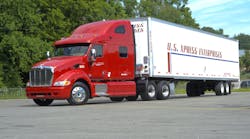Following hard on the heels of Swift Transportation’s driver pay raise announcement in late July, two other major TL carriers are now introducing pay increases of their own.
U.S. Xpress Enterprises plans to boost its base mileage pay for over the road (OTR) solo, non-dedicated truck drivers by an average of 13% effective Aug. 25 while also eliminating its “sliding pay scale” for all OTR solo drivers as well.
Eric Fuller, U.S. Xpress’ COO, noted that for many of the carrier’s drivers, the “sliding pay scale” made it difficult to calculate base pay from week to week. Thus the company is activating what it calls a “simpler” pay structure where all OTR solo drivers will earn the same base mileage pay regardless of their length of haul.
Con-way Truckload, a subsidiary of Con-way Inc., is planning to boost its per-mile pay for new-hire experienced drivers to a total of 42.5 cents per mile starting Sept. 7 and beef up its incentive bonus structure in the bargain as well – an effort aimed at increasing productivity while rewarding drivers for their loyalty, said Joseph Dagnese, the carrier’s president.
On top of that, with respect to layover pay, he noted the carrier is increasing driver compensation from $60 to $75 per day.
“Our drivers are the company’s most important asset,” Dagnese explained. “After listening to their feedback and evaluating current market trends, this is the right time to increase our mileage rate and add new compensation programs which reward driver loyalty, productivity and safe driving performance.”
Based on reaching thresholds for continuous mileage/continuous employment, Con-way Truckload’s enhanced incentive program provides the opportunity to gain additional earnings via an annual bonus of between 1.5 cents and 3 cents per mile on miles driven over the previous 12 months from their anniversary date.
Dagnese added that the mileage pay increase also would apply to Con-way Truckload’s independent contractors as well. “Our independent contractors are a key part of our strategy for providing consistent, high quality capacity and service,” he said.
Jonathan Starks, director of transportation analysis for FTR Transportation Intelligence, noted in the firm’s most recent Trucking Conditions Index report that truck freight continues to show steady increases and, with the tight truck capacity situation unlikely to loosen up any time soon, expects to see both spot and contract rates continue to rise into the fall shipping season.
Yet finding and keeping drivers still remains a tough task for the trucking industry. Bob Costello, chief economist for the American Trucking Assns. (ATA) trade group, noted recently that the industry has in the range of 30,000 to 35,000 unfilled truck driver jobs – a shortage only expected to worsen.
“As the industry starts to haul more because demand goes up, we’ll need to add more drivers – nearly 100,000 annually over the next decade – in order to keep pace,” he said.
Max Fuller, CEO for U.S. Xpress, added in a statement that nearly every facet of the country depends upon some type of goods or services that were delivered by a professional truck driver.
He pointed as well to recent ATA data that stated approximately 70% of the freight shipped annually in the United States was delivered by a truck driver.
“This means more than three million professional truck drivers are transporting more than 9.2 billion tons of freight by driving approximately three million heavy-duty, Class 8 trucks,” Fuller said.
“Drivers are the ones who ensure that our store shelves are not empty, manufacturing does not grind to a halt and our economy does not stall,” he stressed. “With more goods and services being shipped by trucks, we need to expand the workforce so our industry has better trained, more qualified drivers that can take better care of our customers.”



